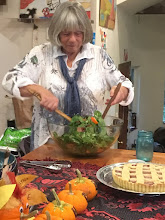[Today, July 20, 2020, is my birthday. That makes this essay, written years ago for my food book, especially relevant.)
Centuries ago, in Ancient Greece, worshipers of Artemis, the moon goddess, would make honey cakes for her on her birthday. To represent the full moon, the worshippers set the tops of the cakes aglow with candles and then, like moons traveling the cosmos, they wound through the streets of Athens to Artemis's temple with their gifts. Thus was born our tradition—in America and in Europe—of birthday cakes and candles.
Last week I made a birthday cake for my friend Joe, who was turning 50-ish. It was a dense chocolate cake, dark as midnight, especially suitable for the glow of the full moon. But I didn't have any birthday candles, so I used a sprinkling of powdered sugar, as though the moon were new, Artemis hidden in the dark, and the stars a-glitter.
If I had been baking this cake int England, or anywhere in Europe, I might have incorporated small gifts into the batter, a tradition that didn't migrate with immigrants across the ocean to the New World. The items found in the pieces of cake foretold the future. If it were a coin, for instance, a guest could expect wealth in life—at lest enough, one might hope, to pay for fixing the tooth one broke when one bit the coin. If a girl found a thimble, she probably went home and cried, knowing she would be a spinster all her life, but if the thimble tumbled from a little boy's piece of cake, he might have gloated at the prospects of finding a good wife. I wondered what I could whip into the batter for Joe: a nail to indicate a sturdy house in winter storms? A marble to suggest the years would roll by smoothly? A pencil eraser to erase all his troubles?
When I was in Denmark for Christmas many years ago, I encountered a similar tradition with a Christmas dessert called risalamande, a kind of rice pudding made with milk and finely chopped almonds. (The recipe will be given with the essay about that Christmas in Denmark, to be posted on December 21 of this year.) Traditionally, the cook included a whole almond in the pudding. Whoever received it was considered lucky. When Ursula handed me the recipe, she told me, with a twinkle in her eye, that I would need a husband to help stir the rice so it wouldn't burn. Perhaps it is because I have lacked a husband all these years that I have never made risalamande. And maybe I never had a husband because I never found a ring in a piece of birthday cake. And so we see the importance of continuing traditions, as we never know what good fortune or bad we might have missed by not having g some prognosticating object tumble from our desserts.
Next week: "The Blue Heron Changes His Mind"
Recipe from this post: Dense chocolate cake
DENSE CHOCOLATE CAKE
Ingredients
7 ounces best-quality dark chocolate
1 stick + 6 tablespoons unsalted European-style butter (the high-butterfat kind, such as Lurpak or Beurre d'Isigny), cut into 1/2-inch cubes
1 1/3 cup granulated sugar
5 large eggs
1 tablespoon unbleached all-purpose flour
Preparation
Preheat the oven to 375º and butter an 8-inch round cake pan. Line the base of the pan with parchment and butter the parchment, too. Finely chop the chocolate. (A serrated bread knife does an outstanding job with this.)
To make
Put the chocolate and the butter in a double boiler or in the microwave oven. Melt gently, stirring regularly to combine. Add the sugar to the chocolate-butter mixture, stirring well, and set aside to cool for a few minutes. then add the eggs one by one, stirring well after each addition, and then add the flour. The batter should be smooth, dark, and utterly gorgeous.
Pour the batter into the buttered cake pan and bake for approximately 25 minutes, or until the center of the cake looks set and the top is shiny and a bit crackly-looking. (I usually set the timer for 20 minutes initially and then check the cake every two minutes thereafter until it's done. At 20 minutes it's usually quite jiggly in the center. It's done when it jiggles only slightly, if at all.) Let the cake cool in its pan on a rack for 10 minus; then carefully turn the cake out of the pan and revert it, so that the crackly side is facing upward. Be very careful. This cake is extremely delicate and won't stand for much manipulation. Allow it to cool completely. It will deflate slightly as it cools.
To serve
Ingredients
The cake
Powdered sugar
Slightly sweetened whipped cream
Sift some powdered sugar over the cake. Serve the cake in wedges at room temperature with a loose dollop of ever-so-slightly sweetened whipped cream. If you use the freshest eggs, highest-quality chocolate, and best butter, you have a real masterpiece in this cake.




No comments:
Post a Comment